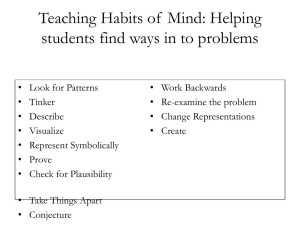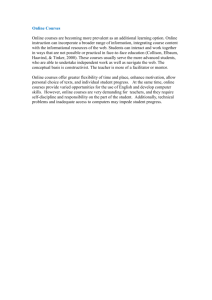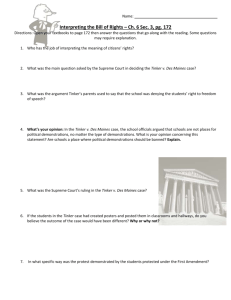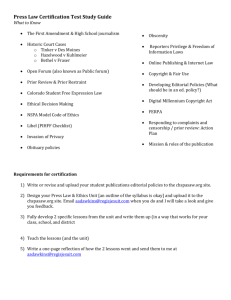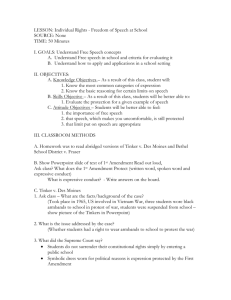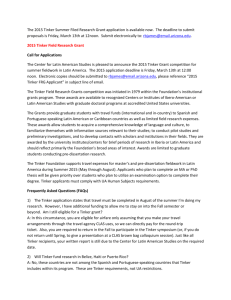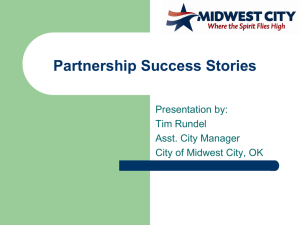Papers Tinker 2007-8 - Confluence
advertisement
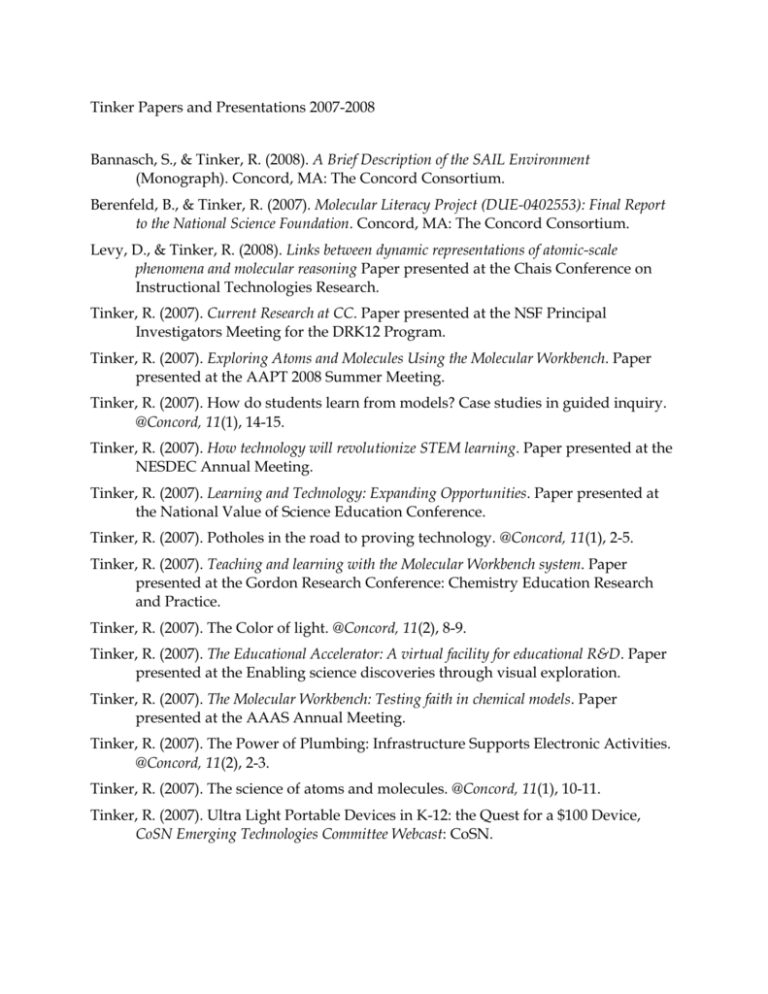
Tinker Papers and Presentations 2007-2008 Bannasch, S., & Tinker, R. (2008). A Brief Description of the SAIL Environment (Monograph). Concord, MA: The Concord Consortium. Berenfeld, B., & Tinker, R. (2007). Molecular Literacy Project (DUE-0402553): Final Report to the National Science Foundation. Concord, MA: The Concord Consortium. Levy, D., & Tinker, R. (2008). Links between dynamic representations of atomic-scale phenomena and molecular reasoning Paper presented at the Chais Conference on Instructional Technologies Research. Tinker, R. (2007). Current Research at CC. Paper presented at the NSF Principal Investigators Meeting for the DRK12 Program. Tinker, R. (2007). Exploring Atoms and Molecules Using the Molecular Workbench. Paper presented at the AAPT 2008 Summer Meeting. Tinker, R. (2007). How do students learn from models? Case studies in guided inquiry. @Concord, 11(1), 14-15. Tinker, R. (2007). How technology will revolutionize STEM learning. Paper presented at the NESDEC Annual Meeting. Tinker, R. (2007). Learning and Technology: Expanding Opportunities. Paper presented at the National Value of Science Education Conference. Tinker, R. (2007). Potholes in the road to proving technology. @Concord, 11(1), 2-5. Tinker, R. (2007). Teaching and learning with the Molecular Workbench system. Paper presented at the Gordon Research Conference: Chemistry Education Research and Practice. Tinker, R. (2007). The Color of light. @Concord, 11(2), 8-9. Tinker, R. (2007). The Educational Accelerator: A virtual facility for educational R&D. Paper presented at the Enabling science discoveries through visual exploration. Tinker, R. (2007). The Molecular Workbench: Testing faith in chemical models. Paper presented at the AAAS Annual Meeting. Tinker, R. (2007). The Power of Plumbing: Infrastructure Supports Electronic Activities. @Concord, 11(2), 2-3. Tinker, R. (2007). The science of atoms and molecules. @Concord, 11(1), 10-11. Tinker, R. (2007). Ultra Light Portable Devices in K-12: the Quest for a $100 Device, CoSN Emerging Technologies Committee Webcast: CoSN. Tinker, R. (2007, January). Understanding the atomic-scale world with the Molecular Workbench. Paper presented at the Winter Meeting of the American Association of Physics Teachers, Seattle, WA. Tinker, R. (2007). Unifying Science with Fundamental Concepts Enabled by Technology. Paper presented at the NSF Principal Investigators Meeting for the DRK12 Program. Tinker, R. (2007). Visualizing chemical reactions one step at a time. @Concord, 11(2), 1415. Tinker, R. (2008). Exploring the Science of Atoms and Molecules Using the Molecular Workbench. Paper presented at the AAPT Annual Winter Meeting. Tinker, R. (2008). Learning What Students Are Thinking Paper presented at the AAPT Winter Meeting. Tinker, R. (2008). Perspective: The Concord Consorium vision. @Concord, 12(1), 2-3. Tinker, R. (2008d). The Molecular Workbench. Paper presented at the Meeting at the Jackson Lab. Tinker, R., & Bell, K. (2008). The Center for Enhanced Learning of Science. @Concord, 12(1), 10-11. Tinker, R., Galvis, A. H., & Zucker, A. (2007). 1:1 computing in support of science and mathematics education: Recommendations for large-scale implementations. Concord, MA: The Concord Consortium. Tinker, R., & Palant, A. (2008). Understanding heat and temperature: Can atoms help? @Concord, 12(1), 6-7. Tinker, R., Palant, A., & Damelin, D. (2008). Frontier uses of the Molecular Workbench in the classroom. Paper presented at the NSTA National Meeting. Tinker, R., & Pallant, A. (submitted 2007). Stepping stones to molecular literacy: Enhancing high school biology with dynamic molecular models. Journal of Science Education and Technology. Tinker, R., Pallant, A., Xie, Q., & O'Sullivan, E. (2007). Using Molecular Dynamics Models to Help Students Understand Light-Matter Interactions. Paper presented at the AERA. Tinker, R., Pallant, A., Xie, Q., & O'Sullivan, E. (submitted 2007). Using molecular dynamics models to help students understand light-matter interactions. Journal of Science Education and Technology. Tinker, R., & Staudt, C. (2008a). The Molecular Workbench: Linking the Micro and Macro. Paper presented at the NSTA National Conference. Tinker, R., & Staudt, C. (2008b). The Science of Atoms and Molecules. Paper presented at the NSTA National Conference. Tinker, R., Staudt, C., & Hazzard, E. (2008). Probes and Models in the High School. Paper presented at the NSTA National Conference. Tinker, R., & Xie, Q. (2007). Roving around molecules. @Concord, 11(1), 8-9. Tinker, R., & Xie, Q. (2008). Applying computational science to education: the Molecular Workbench paradigm. Computing in Science and Engineering, 10(5), 24-27. Tinker, R., & Xie, Q. (Invited for 2009). Infusing Science into Science Education. Science. Tinker, R., Xie, Q., O'Brian, E., & Pallant, A. (2007). Chemistry visualization and student learning: Light-matter interactions using Molecular Workbench models. Paper presented at the AERA Annual Meeting. Zucker, A., Galvis, A. H., & Tinker, R. (2007). Probeware and the XO. @Concord, 11(1), 1, 4-5. Zucker, A., Tinker, R., Staudt, C., Mansfield, A., & Metcalf, S. (2008). Learning science in grades 3-8 using probeware and computers: Findings from the TEEMSS II project. Journal of Science Education and Technology, 17(1), 42-48.
